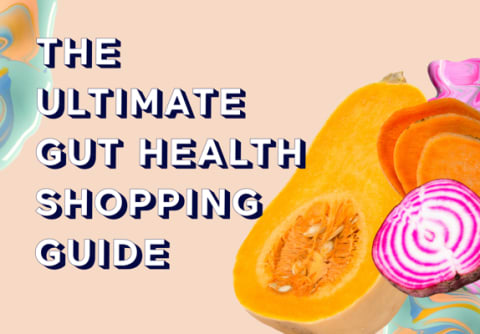Advertisement
25 High-Fiber Foods To Help Meet Your Daily Requirements


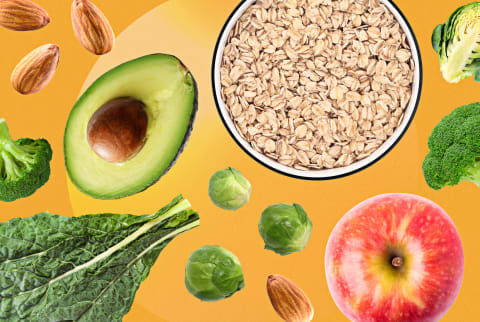
Despite its many health benefits, fiber is lacking in the typical American diet. In fact, the average daily intake of fiber is so low the USDA considers it a public health concern. Here's why fiber is so important, and the foods to prioritize to make sure you're getting enough of it.
Benefits of fiber
Eating enough fiber can help to reduce the body's blood sugar response1 to certain foods, increase mineral absorption2, and improve feelings of satiety3.
Plus, "fiber aids in the reduction of total and LDL cholesterol4 by binding to cholesterol in the gastrointestinal tract and moving it out of circulation," says registered dietitian and nutritionist Maya Feller, M.S., R.D., CDN. "These actions reduce the risk of developing cardiovascular disease and type 2 diabetes5," Feller says.
It also helps your digestion run smoothly. Eating fiber can also help promote bowel regularity and support a healthy weight.6 It may even reduce the risk of certain cancers7, according to clinical research.
mbg tip
How much do I need?
The average American is eating about 16 grams of fiber8 daily, but the dietary recommendations for fiber are far higher:
Recommended fiber intake by age
| Age | Male | Female |
|---|---|---|
| 1-3 years | 19 grams/ day | 19 grams/ day |
| 4-8 years | 25 grams/ day | 25 grams/ day |
| 9-13 years | 31 grams/ day | 25 grams/ day |
| 14-50 years | 38 grams/ day | 25 grams/ day |
| 51+ years | 30 grams/day | 21 grams/ day |
| Pregnancy | - | 28 grams/ day |
| Lactation | - | 29 grams/day |
In order to fill what nutritionists call "the fiber gap," consider adding these high-fiber 25 foods to your diet. (Pssstt... starting your day with a fiber-rich breakfast can help!)
Grains
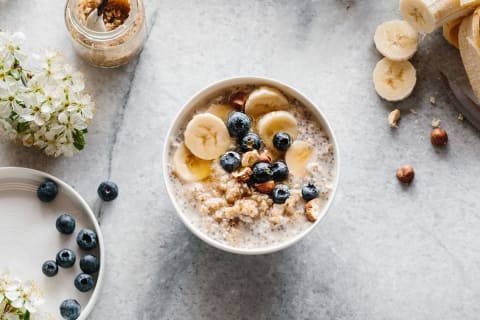
Oats
Fiber: 8 to 16 grams per cup.
A standard serving size of steel cut oats is 1/4 cup, and a standard serving size of old fashioned rolled oats is 1/2 cup.
Start your morning off with 1 cup of steel cut oats, and you're already at 16 grams of fiber, according to Feller. Add blueberries or strawberries to the mix for an added boost.
Try this: Collagen-packed overnight oats recipe
Buckwheat
Fiber: 17 grams per cup.
"When compared to other grains," registered dietitian Nour Zibdeh, M.S., RDN, says "buckwheat—which is technically a seed—has more fiber and protein." Just 1 cup contains 17 grams of fiber.
Try this: Chocolate buckwheat pancake recipe
Barley
Fiber: 6 grams per cup.
Barley is a type of grain, commonly used as a base for grain bowls. If you're able to tolerate gluten, eating 1 cup of cooked barley will give you about 6 grams of fiber.
Quinoa
Fiber: 4 grams per cup.
Quinoa is a whole grain, which means it's naturally high in fiber. According to registered dietitian Isabel Smith, R.D., CDN, there are four varieties of quinoa: white, red, black, and tricolor. White is the most common, and it contains about 4 grams of fiber per cup.
Fruits
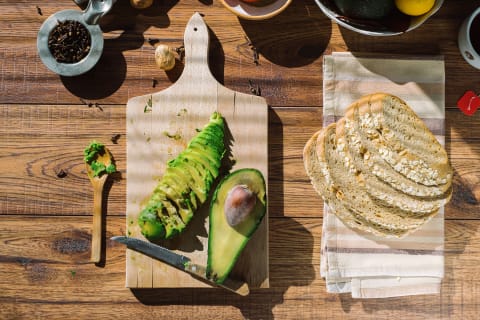
Avocado
Fiber: 13.5 grams, one avocado.
"Avocado is rich in insoluble fiber," research specialist in oncology nutrition L.J. Amaral, M.S., R.D., CSO, says. "And it contains 13.5 grams of total dietary fiber." Eat it on its own with sea salt and red pepper, or mash it on top of whole wheat bread for extra fiber.
Try one of these 9 avocado dessert recipes.
Apples
Fiber: 4.4 grams, one medium apple.
You know an apple a day keeps the doctor away, and maybe fiber has something to do with that. "One medium apple contains over 4 grams of fiber," Feller says. They're also high in calcium, potassium, and vitamin C.
Berries
Fiber: 4 to 8 grams per cup.
Blackberries and raspberries both provide about 8 grams of fiber per cup, while blueberries provide 4 grams. The berries are also a good source of polyphenols, which play a role in metabolism, as well as chronic disease and weight management.
Try one of these 9 antioxidant-rich breakfast recipes
Pears
Fiber: 5 grams, one medium pear.
One medium-size pear contains more than 5 grams of fiber. Pears also contain high amounts of immune-supporting antioxidants9, like vitamin C.
Prunes
Fiber: 2 grams per three to four prunes.
The fiber content in prunes helps relieve constipation. If you're looking to stay regular, functional medicine doctor Elizabeth Boham, M.D., M.S., R.D., recommends eating three or four prunes at a time, which provides about 2 grams of fiber.
Try this: 5-ingredient chocolate energy bites
Guava
Fiber: 9 grams per cup.
Just 1 cup of guava contains 9 grams of fiber and about 377 mg of vitamin C. Studies have shown that the fruit possesses anti-inflammatory and antimicrobial10 properties—in case you needed another excuse to eat it.
Try this: Homemade gluten-free guava coconut bars
Bananas
Fiber: 3 grams, one medium banana.
Since bananas are berries, it's no surprise they're also high in fiber. Eating one medium-sized banana increases your fiber intake by about 3 grams.
Vegetables
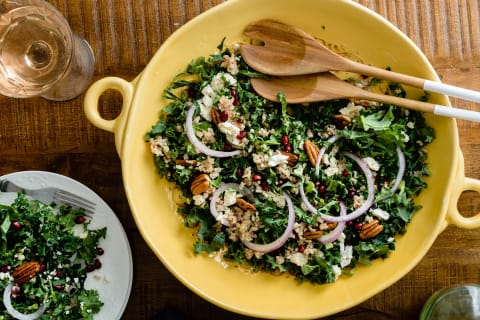
Kale
Fiber: 3 grams per 2 cups.
Kale is rich in a variety of vitamins and minerals, including vitamins A, C, and K, and can also add to your fiber intake. Eating 2 cups of baby kale provides nearly 3 grams of fiber.
Try this: Protein-packed green smoothie recipe
Broccoli
Fiber: 5 grams per cup.
One cup of broccoli florets contains about 5 grams of fiber. The veggies are also high in sulfur—one of the most abundant minerals in the body—which helps to metabolize food11. In other words, these nutrient-packed florets can be great for the gut.
Try this: Garlic, tofu, & broccoli stir-fry recipe
Brussels sprouts
Fiber: 3 grams per cup.
Just like broccoli, Brussels sprouts are a cruciferous veggie high in healthy sulfur and fiber (3 grams per cup). If Brussels are making you bloat, naturopathic doctor Kellyann Petrucci, M.S., N.D., suggests steaming them so they're easier to digest.
Try this: Vegan wild rice salad recipe
Cauliflower
Fiber: 5 grams, one small head.
One small head of cauliflower contains 5 grams of dietary fiber. Using ground cauliflower in place of rice is a simple way for people on grain-free diets to meet their fiber needs.
Try this: Sunny collagen-turmeric smoothie
Artichokes
Fiber: 7 grams per artichoke.
Surprisingly enough, artichokes are one of the highest sources of fiber from a vegetable. One artichoke contains almost 7 grams of fiber, and registered dietitian Molly Knudsen, M.S., RDN, says one can of artichokes contains about 5.
Try this: Healthy spinach artichoke dip recipe
Sweet potatoes
Fiber: 6 grams per sweet potato.
Sweet potatoes are a great source of both soluble and insoluble fiber, which can promote gut health and regular digestion. Eating one sweet potato with the skin on provides almost 6 grams of fiber.
Try this: Sweet potato breakfast porridge
Legumes
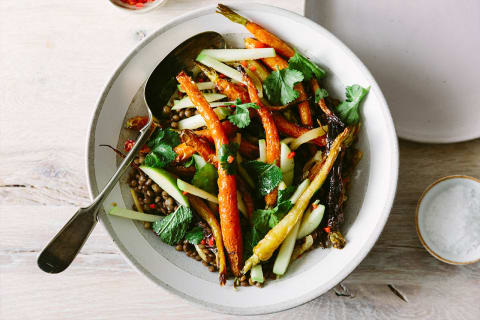
Lentils
Fiber: 15 grams per cup.
Try one of these 10 lentil-based recipes.
Split peas
Fiber: 16 grams per cup.
Split peas are similar to lentils, but they're grown from a different plant: the field pea. They're called split peas because after being dried and hulled, they're split down the middle. One cup of cooked split peas contains 16 grams of dietary fiber.
Try this: Pea protein milk recipe
Chickpeas
Fiber: 10 grams per cup.
Chickpeas are a staple in most diets but especially in vegan and vegetarian diets. The legumes provide high amounts of plant-based protein and fiber—10 grams per cup. When dried, they can also be ground into a fibrous, gluten-free flour.
Try this: Everything chickpeas snack recipe
Fava beans
Fiber: 9 grams per cup.
Fava beans, also known as broad beans, are a good source of the minerals manganese, copper, phosphorus, magnesium, iron, and potassium, according to registered dietitian Megan Fahey, M.S., R.D., CDN. She adds that they contain 9 grams of fiber per serving.
Try this: Salade niçoise recipe
Lima beans
Fiber: 15 grams per cup.
Another good source of plant-based protein and fiber are lima beans—1 cup of boiled lima beans contains 15 grams of protein and almost 14 grams of dietary fiber. They also contain nutrients like iron, magnesium, and potassium.
Try this: 5-ingredient artichoke salad
Nuts and seeds
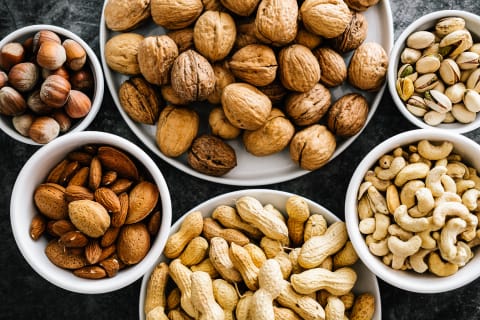
Almonds
Fiber: 4 grams per ounce (or 14.9 g per cup.)
Not only are almonds rich in protein (6 grams), but Feller says 1 ounce of almonds also contains 4 grams of fiber. The nutrient combo makes almonds an ideal snack when you want to stay satiated for a long period of time.
Try this: No-bake chocolate fudge recipe
Chia seeds
Fiber: 9 grams per 2 tablespoons.
Just 2 tablespoons of chia seeds contain more than 9 grams of fiber. Adding these high-fiber seeds to your oatmeal or smoothie is a simple way to up your fiber intake first thing in the morning.
Try one of these 4 chia pudding recipes
Sunflower seeds
Fiber: 12 grams per cup.
Enjoy sunflower seeds as a tasty snack or on top of creamy soups. One cup contains 12 grams of fiber. They also provide 9% of the recommended daily intake for magnesium and 14% of zinc.
Frequently Asked Questions
What foods have the most fiber?
Beans, berries, avocados, green veggies and whole grains like buckwheat are just a few foods that are especially high in fiber.
How much fiber do I need per day?
The recommended fiber intake for adults is around 25 grams for women and 38 grams for men.
Can you get enough fiber from food alone?
Yes, you can definitely get enough fiber from food alone. Aim to eat a wide range of fruits and vegetables with each meal. If you're worried you're not meeting your fiber goals, you might want to try a fiber supplement—just speak with your doctor first.
The takeaway
Fiber is an important nutrient that we don't seem to be consuming enough of. Luckily, these 25 fiber-filled foods above can easily up your fiber intake. If you're not used to eating so much fiber, introduce it into your diet gradually to reduce the risk of stomach upset.
11 Sources
- https://pubmed.ncbi.nlm.nih.gov/10805824/
- https://pubmed.ncbi.nlm.nih.gov/12514257/
- https://pubmed.ncbi.nlm.nih.gov/36193993/
- https://pubmed.ncbi.nlm.nih.gov/9925120/
- https://www.ncbi.nlm.nih.gov/pmc/articles/PMC5731843/
- https://pubmed.ncbi.nlm.nih.gov/31174214/
- https://pubmed.ncbi.nlm.nih.gov/27193606/
- https://www.ncbi.nlm.nih.gov/pmc/articles/PMC6124841/
- https://www.ncbi.nlm.nih.gov/pubmed/29099763
- https://www.ncbi.nlm.nih.gov/pmc/articles/PMC4127827/
- https://www.ncbi.nlm.nih.gov/pmc/articles/PMC6521024/
